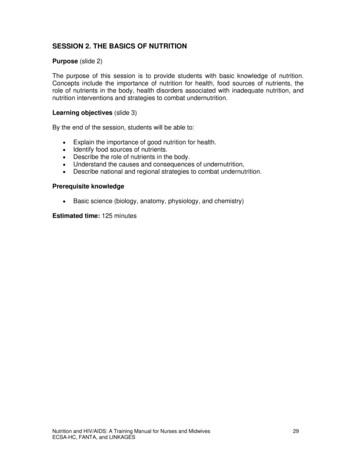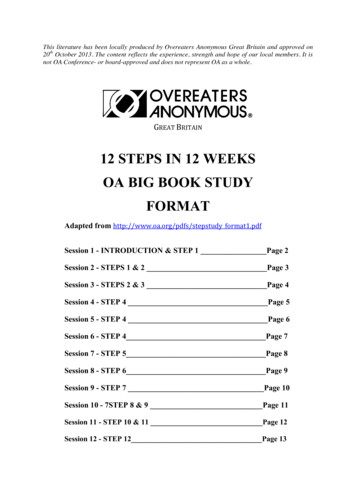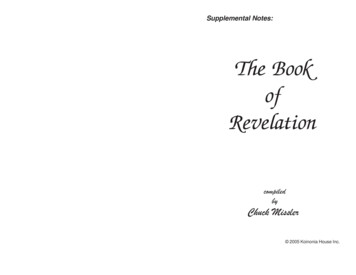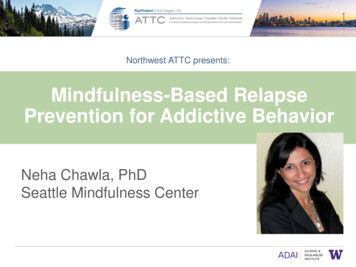
Transcription
SESSION 2. THE BASICS OF NUTRITIONPurpose (slide 2)The purpose of this session is to provide students with basic knowledge of nutrition.Concepts include the importance of nutrition for health, food sources of nutrients, therole of nutrients in the body, health disorders associated with inadequate nutrition, andnutrition interventions and strategies to combat undernutrition.Learning objectives (slide 3)By the end of the session, students will be able to: Explain the importance of good nutrition for health.Identify food sources of nutrients.Describe the role of nutrients in the body.Understand the causes and consequences of undernutrition,Describe national and regional strategies to combat undernutrition.Prerequisite knowledge Basic science (biology, anatomy, physiology, and chemistry)Estimated time: 125 minutesNutrition and HIV/AIDS: A Training Manual for Nurses and MidwivesECSA-HC, FANTA, and LINKAGES29
Session guide (slide s)Good nutrition andrelated terms andconceptsParticipatorylectureDiscuss terms related tofood and nutrition.5Essential nutrients:Macronutrients andmicronutrientsParticipatorylecture andgroup activityDescribe and defineessential nutrients.Discuss which local foodscontain specific essentialnutrients.15Energy requirements foradults, adolescents, andchildren and infantsParticipatorylecture andindividualactivityDescribe energyrequirements and discussrequirements for differentage groups. CompleteExercise 1 and discussanswers.20Protein requirements foradults, adolescents, andchildren and infantsParticipatorylectureDescribe proteinrequirements for differentage groups.15The causes ofundernutrition and itsimpact on societyParticipatorylectureDescribe undernutrition inAfrica. Discuss students’understanding ofundernutrition in theircommunities.10Protein energymalnutrition (PEM) andbody mass index (BMI)Participatorylecture andindividualexerciseDescribe PEM, itsdiagnosis, and strategiesfor prevention and control.Complete Exercise 2 anddiscuss answers.15Anemia, iron deficiencydisorders (IDD), andvitamin A deficiency(VAD)Participatorylecture andindividualexerciseCauses, manifestations,and diagnosis of anemia,IDD, and VAD andstrategies to control andprevent other nutritionrelated conditions15Case studiesExercise andgroupdiscussionAsk students to completeExercises 3–5 and discussanswers.15Conclusions5Review5Total time120Nutrition and HIV/AIDS: A Training Manual for Nurses and MidwivesECSA-HC, FANTA, and LINKAGES30
Required materials Flipchart paper and standMarker pensBlackboard and chalk or whiteboard and markersErasersOverhead project and transparencies or LCD project and laptopMaterials provided PowerPoint 2Handout 2.1. Macronutrient and Micronutrient Food Sources, Functions,and Manifestations of DeficienciesHandout 2.2. Nutrition CalculationsHandout 2.3. Length/Height for Age and Weight for AgeHandout 2.4. Body Mass Index Reference TablePreparation Review Lecture Notes and PowerPoint 2.Review handouts and identify questions to help students master the concepts.Collect samples or pictures of local foods.Suggested readingFood and Agriculture Organization of the United Nations (FAO) and World HealthOrganization (WHO). 1998. Human Vitamin and Mineral Requirements. Report of a JointFAO/WHO Expert Consultation. Rome: FAO.FAO, WHO, and United Nations University (UNU). 1985. Energy and ProteinRequirements. Report of a Joint FAO/WHO/UNU Expert Consultation. WHO TechnicalReport Series No. 724. Geneva: WHO.Latham, M. C. 1997. Human Nutrition in the Developing World. FAO Food and NutritionSeries No. 29. Rome.Related termsBalanced diet – The daily provision of a variety of foods which include all the nutrientsin the right amounts and combinations required to meet the body’s functional needsDiet – The customary amount and kind of food and drink a person takes in day to dayCarbohydrates – The main sources of energy in the diet, referred to as energy-givingfoodsEnergy requirement – The amount of energy needed to maintain health and growthand support an individual level of physical activityLipids – Fat-soluble compounds high in energy that can be found in solid or liquid formNutrition and HIV/AIDS: A Training Manual for Nurses and MidwivesECSA-HC, FANTA, and LINKAGES31
Macronutrients – Nutrients (carbohydrates, fats, and proteins) needed by the body inrelatively large quantities, measured in grams per dayMalnutrition – A condition caused by inadequate or excess intake of nutrientsMeal – Food served or eaten at a given time during the day (e.g., breakfast, lunch,dinner)Micronutrients – Nutrients (vitamins and minerals) needed by the body in very smallquantities, usually less than 1 gram per dayMinerals – Inorganic compounds which must be obtained outside the body, required forchemical and metabolic functionsNutrients – Substances or components of food which contain carbohydrates, proteins,fats (lipids), vitamins, minerals, and waterNutrition – The sum of all processes involved in taking in food and the body’sassimilation and use of the foodNutritional status – The health status of the body in relation to a nutrient or group ofnutrientsOvernutrition – A condition caused by excess intake of nutrientsProteins – Macronutrients essential for body growth and building and repairing tissuesand musclesUndernutrition – A condition caused by inadequate intake of nutrientsVitamins – Organic compounds that performs specific metabolic functions in the bodyNutrition and HIV/AIDS: A Training Manual for Nurses and MidwivesECSA-HC, FANTA, and LINKAGES32
Introduction (slide 5)Nutrition is the sum of all processes involved in the intake, assimilation, and utilization ofthe proper amounts of nutrients to maintain health, well-being, and productivity. Goodnutrition relies on a diverse, adequate diet and is essential for the development andmaintenance of the body from infancy to old age. Nutritional status can be both the“cause” and the “outcome” of good or poor health.The terms “nutrition” and “food” are closely related but not interchangeable. Nutrition is aprocess of events, while food is a product that is eaten or taken into the body. Food isessential because it contains nutrients that the body needs for the following: Developing, growing, maintaining, replacing, and repairing cells and tissuesResisting and fighting infection and recovering from illnessProducing energy, warmth, movement, and workCarrying out chemical processes such as digestionNutrition basicsNutrients are the substances in food that the body uses to function properly. Nutrientsare divided into macronutrients and micronutrients.Macronutrients are nutrients needed by the body in relatively large quantities (manygrams per day and include carbohydrates, fats, and proteins.Micronutrients are nutrients needed by the body in very small quantities (usually lessthan 1 gram per day) and include vitamins and minerals.The body ingests, assimilates, and utilizes the nutrients in food to meet its needs formacronutrients and micronutrients. The body’s physical and chemical process ofbreaking down food and converting it into a useful form of energy is called metabolism.The energy produced by metabolism is essential to maintain the body’s functions anddaily activities. The ability to metabolize food may vary from person to person and maybe affected by illness or disease. Balancing the body’s ability to metabolize food with anappropriate quantity of nutrients and food types will help ensure good health.Each person processes and uses nutrients differently. The body responds eitherpositively or negatively when it absorbs a nutrient or group of nutrients. The responseaffects the body’s condition and health status. The body’s response to nutrients and thesubsequent outcome is called nutritional status. The amount and type of food anddrink a person eats is called the diet. A nutritious or balanced diet includes a variety offoods and the proper nutrients in the correct amounts and combinations to meet thebody’s functional needs. A healthy and balanced diet should contain food free of harmfulsubstances and in the optimal amounts and mixtures.Eating a variety of foods is key to good health, especially for people with special needs,such as infants and young children, pregnant and lactating women, and the elderly.Eating a wide assortment of foods increases the likelihood of getting the necessarynutrients. Except for breastmilk, no single food provides all the nutrients the body needsto function properly.Nutrition and HIV/AIDS: A Training Manual for Nurses and MidwivesECSA-HC, FANTA, and LINKAGES33
In summary, good nutrition involves eating a variety of safe and appropriate foods in thecorrect quantities to meet the body’s needs for health and well-being.The essential nutrient groups (slide 6)To function properly, the body must maintain a proper balance of the following keynutrients: CarbohydratesProteinsFatsVitaminsMineralsWaterAs mentioned earlier, these nutrients are divided into macronutrients and micronutrients.People must eat the appropriate amount of all these nutrients to be well nourished. ReferHandout 2.1. Macronutrient and Micronutrient Food Sources, Functions, andManifestations of Deficiencies lists the essential nutrients and their sources, functions,and deficiencies.MacronutrientsMacronutrients are the main sources of energy in the diet. Their contribution to individualdiets may vary.Carbohydrates (slide 7)Carbohydrates are called energy-giving foods because they make up a large percentageof the energy in people’s diets. In developing countries the basic foods that people eatregularly (staple foods) are usually high in carbohydrates. In fact, carbohydrates accountfor up to 80 percent of the total energy in diets in developing countries, compared with45–50 percent in industrialized countries (Lantham 1997). Staple foods often containother essential nutrients such as protein, vitamins, and minerals, but in smaller amounts.Staple foods are usually produced locally and are readily available, accessible, andaffordable.Rich sources of carbohydrates include cereals (rice, millet, sorghum, wheat, and barley),root crops (cassava, sweet potatoes, yams, and potatoes), and starchy fruits (greenbananas and plantains). These foods contain what are known as complexcarbohydrates. Complex carbohydrates usually provide more fiber, vitamins, andminerals than simple carbohydrates (FAO 1998). Simple carbohydrates provide energybut are often called “empty calories” because they lack the extra vitamins and mineralsfound in complex carbohydrates. Simple carbohydrates are quickly digested andabsorbed because they lack fiber. They include sugar, honey, and baked goods such asdoughnuts and cake.Carbohydrates cannot meet all the body’s energy needs because they do not provide allthe essential nutrients. People should eat other kinds of food in combination with staplefoods for a nutritious and well-balanced diet.Nutrition and HIV/AIDS: A Training Manual for Nurses and MidwivesECSA-HC, FANTA, and LINKAGES34
Lipids (slide 8)Lipids are found in fats and oils and are a concentrated source of high energy that isslowly absorbed by the body. Lipids provide essential fatty acids that the body does notproduce itself and has to get from food. In developing countries lipids represent only 8percent of the total energy in people’s diets, compared with as much as 36 percent inhigh-income countries (Latham 1997).Foods that contain lipids generally have a satisfying taste, ensuring that people includethem in their diets. These foods include butter, margarine, and lard, which are solid atroom temperature, and corn oil, olive oil, cotton oil, linseed oil, and soybean oil, whichare liquid at room temperature.Lipids are categorized as visible and invisible fats. Visible fats are easily recognized andinclude butter, margarine, vegetable oils, bacon fat, and lard. Their lipid content can bemeasured accurately. Invisible fats are not seen or measured as easily and are found inmilk, nuts, avocados, cheese, egg yolks, and baked goods such as cake.The body digests and absorbs liquids more slowly than carbohydrates and proteins.Lipids leave people feeling satisfied longer and provide nearly twice as much energy asother macronutrients. Because they are energy dense, lipids are important for peoplewho need to gain weight. Because dietary lipids also help the body transport and absorbfat-soluble vitamins, they may be a good source of vitamins A, D, E, and K. However,eating too many lipids may lead to heart disease, obesity, and related complications.People should therefore eat lipids sparingly.Proteins (slide 9)Known as body-building foods, proteins form the main structural components of cellsand, apart from water, make up the bulk of tissues and organs. The body needsadditional protein from the diet to grow, develop, maintain, and repair tissues andmuscles. Proteins are necessary for the following: Growth and developmentMaintenance and repair of tissues and replacement of worn-out or damagedtissuesProduction of metabolic and digestive enzymesMake up of certain hormones and all cells and tissuesThere are two main types of protein: plant protein, which includes legumes (e.g., beans,lentils, soybeans, and chickpeas), groundnuts, and other nuts and 2) animal protein,which includes meat, poultry, fish, insects, milk, cheese, and eggs.Proteins are made of amino acids, some of which are absolutely essential for humans.Not all proteins have the same quality and nutritional importance. Proteins in some foodsdo not contain the full range of essential amino acids that the body needs. Foods suchas milk and eggs contain high-quality, easily digested proteins with the essential aminoacids. Foods such as maize and wheat contain protein with fewer essential amino acidsand are less easily digested.Nutrition and HIV/AIDS: A Training Manual for Nurses and MidwivesECSA-HC, FANTA, and LINKAGES35
Animal protein is often of high quality and as a result contains more of the amino acids,vitamins, and minerals needed for the body’s proper functioning. When people do noteat enough protein, their bodies use protein from their muscle mass, leading to musclewasting over time.MicronutrientsMicronutrients are needed in very small amounts but play an important role in the properfunctioning of the body. Micronutrients include vitamins and minerals that the bodyneeds to produce various hormones and enzymes to develop and maintain systemsincluding the immune and reproductive systems.Vitamins (slide 10)Vitamins are organic compounds that perform specific metabolic functions in the body.The body does not synthesize most vitamins and must get them from food. Unlikecarbohydrates, lipids, and proteins, vitamins do not produce energy. However, they arenecessary for many of the metabolic processes that produce energy. People who do noteat the proper amounts of vitamins can get vitamin deficiencies that cause illness anddisease.Vitamins are classified into two categories based on the substances they dissolve in.Fat-soluble vitamins can be stored by the body when they are not used. Thesevitamins are essential for good health but not needed every day. Fat-soluble vitaminsinclude A, D, E, and K. These vitamins are necessary for the development andmaintenance of certain body tissues, including those in the eyes (vitamin A), bones(vitamin D), and muscles; for the coagulation of blood (vitamin K); for synthesizingcertain enzymes, and for absorbing other essential nutrients such as calcium (vitamin D)(Latham 1997).Water-soluble vitamins pass directly into the bloodstream. The body has limited abilityto store these vitamins and must get them daily from food. Water-soluble vitaminsinclude C (ascorbic acid), B1 (thiamine), B2 (riboflavin), B3 (niacin), B6 (pyroxidine), B12(cobalamin), pantothenic acid, and folic acid.These vitamins are often classified by their functions. Energy-releasing vitamins thatenable the body to use macronutrients include B1 (thiamine), B2 (riboflavin), B3 (niacin ornicotinic acid), biotin, and pantothenic acid. Hematopoietic (red blood cellsynthesizing) vitamins that help the body make new red blood cells include folacin(folic acid) and B12 (cobalamin). Co-enzyme vitamins that help the body break downamino acids, produce enzymes, and synthesize new proteins include B6 (pyroxidine),which helps metabolize protein, and others. Skin- and bone-building vitamins thathelp form collagen, an important component of skin, bone, and connective tissuesinclude C (ascorbic acid).Minerals (slide 11)Minerals are inorganic compounds that are not produced by the body but are necessaryfor health and well-being. Minerals are referred to as essential trace elements becausethey are needed in very small quantities. While they are chemically different fromNutrition and HIV/AIDS: A Training Manual for Nurses and MidwivesECSA-HC, FANTA, and LINKAGES36
vitamins, minerals serve similar purposes. They influence many of the body’sbiochemical reactions and are used to form cells and tissues.Important minerals for health include iron, zinc, calcium, and iodine. Iron is an essentialcomponent of blood and helps transfer oxygen to various tissues. Zinc is important toenhance and strengthen the immune system, help wounds heal, and facilitate digestionand is an important component of the skeletal system. Calcium is a key component ofbone and is needed for a strong skeleton. Other minerals involved in various bodyreactions are chromium, copper, fluoride, magnesium, manganese, molybdenum, nickel,phosphorus, and selenium.Water (slide 12)Water is considered an essential nutrient because it is necessary for body functionsincluding digestion and absorption and certain metabolic processes. Water is also aprimary component of the body, representing over 60 percent of a person’s weight.Water regularly leaves the body through sweating, excretion, and breathing andtherefore must be replaced. Adults should drink at least 2 liters or about 8 cups of watera day. The water should be safe, clean, and boiled if necessary. Tea, soup, milk, juice,and fruit also contain water and can help meet the body’s needs. The caffeine in tea andcoffee, however, can dehydrate the body and should be drunk in moderation. Tea andcoffee also contain substances that bind essential nutrients such as iron, making thesenutrients unavailable for the body to use.To maintain a well-balanced diet, people should eat a variety of foods that contain all thenutrients mentioned above in the right daily amounts and combinations to meet thebody’s functional needs.Nutrient requirements of adults and children: Energy (slides 13 and 14)Energy requirements are the “amount of food energy needed to balance energyexpenditure in order to maintain body size, body composition, and a level of necessaryand desirable physical activity consistent with long-term good health (FAO, Who, UNU2004). Essentially, energy requirements are the general guidelines for attaining andmaintaining a health life that reflect the body’s dietary and expenditure needs. Theserequirements vary according to age and gender. Infants, children, adolescents, pregnantand lactating women, other adults, and the elderly all have different energy requirementsand should eat a well-balanced diet that takes into account their various needs. Energyrequirements are also based on the following factors: Basal metabolism—the minimal energy expenditure needed to maintain thebasic body functions needed for life, such as the functioning of vital organs andthe nervous system. The basal metabolic rate (BMR) is used to determine basalmetabolism over a standard period of time and can represent from 45 to 70percent of daily energy needs.Metabolic response to food—the level of energy needed to digest, absorb, andutilize all food eaten.Physical activity—all daily activities ranging from work to play to rest. Theseactivities may be occupational, associated with work, or discretionary, associatedwith household and social tasks.Nutrition and HIV/AIDS: A Training Manual for Nurses and MidwivesECSA-HC, FANTA, and LINKAGES37
Physiological needs—Young children have added energy needs to supportgrowth and development. Pregnant and lactating women need additional energyto support the growth of the fetus, the placenta, maternal tissues, and milkproduction (FAO, WHO, UNU 2004).Estimating energy requirements for adults (slide 15)Energy requirements and the dietary intake needed to meet these requirements maychange from day to day. These definitions are estimates of the appropriate energy for aparticular group of people. Energy requirements are measured in calories and aredetermined by multiplying the BMR by an activity multiplier. The BMR is one of the mostimportant determinants of energy requirements. It is calculated using age, gender,height, and weight. Table 1 shows the BMR for males and females of various ages andweight.Table 1. Equations for estimating BMR from body weightAge (years)Kcal/dayMales18–3015.1 x weight (kg) 69230–6011.5 x weight (kg) 873 6011.7 x weight (kg) 588Females18–3014.7 x weight (kg) 49630–608.7 x weight (kg) 829 6010.5 x weight (kg) 596Source: FAO, WHO, and UNU. 1985.Table 2 shows multiples of BMR used to determine the average daily energyrequirements of adults based on their physical activity. Activities are classified as light(e.g., the work of an office clerk), moderate (e.g., the work of a subsistence farmer), andheavy (e.g., the work of a laborer). The equation for determining estimated energyrequirements based on activity is kcal/day BMR x activity factor.Table 2. Activity 61.641.82As an example, to determine the estimated daily energy required by a healthy 35-year old man who weighs 70 kg and does heavy activity, we would multiply 2.10 x BMR, or2.10 x (11.5 x 79 kg 873). This would give us 3,534 kcal/day.Nutrition and HIV/AIDS: A Training Manual for Nurses and MidwivesECSA-HC, FANTA, and LINKAGES38
Exercise 1. Determine the energy requirement of a 23-year-old woman who weighs 53 kgand does farming and household work (moderate activity).BMR: x kg kcal/dayTotal kcal/day: BMR of x activity factor of kcal/dayAnswers to the exercises are found in Appendix 1.To quickly estimate energy requirements, assume that healthy adults who are not obeseneed 25–35 kcal per kg of body weight (Ireton-Jones and Turner 1991). This estimateshould only be used when BMR equations and activity factors are not readily available.Handout 2.2. Nutrition Calculations can be used to calculate BMR and find the energyand protein requirements of children and adults.Estimating energy requirements for pregnant and lactating womenThe energy needs of women of reproductive age often increase because of thedemands of pregnancy, lactation, and even menstruation.PregnancyDuring pregnancy women need extra energy and nutrients for the growth of the fetus,the placenta, and associated maternal tissues. A pregnant woman who neglects herenergy requirements and proper diet may have a higher risk of giving birth to anunhealthy child. Energy demands gradually increase over pregnancy, with the mostenergy needed during the third trimester. However, a woman can meet her energyneeds throughout the 9 months of pregnancy if she gets the added energy in table 3every day. The body can store extra energy absorbed early in pregnancy and use itwhen demand increases. Energy levels differ based on activity levels.Table 3. Added daily energy requirements of pregnant womenFull activity285 kcal/dayReduced activity200 kcal/daySource: FAO, WHO, and UNU. 1985.LactationEnergy and nutrient requirements increase during lactation for milk production andsecretion. Meeting these needs is important for the health of the infant, as manynutrients provided by breastmilk come from the mother’s diet. Table 4 shows theadditional energy needed by lactating women.Nutrition and HIV/AIDS: A Training Manual for Nurses and MidwivesECSA-HC, FANTA, and LINKAGES39
Table 4. Added daily energy requirements of lactating womenFirst 6 months500 kcal/daySecond 6 months500 kcal/daySource: FAO, WHO, and UNU. 1985.Estimating energy requirement for children and adolescents 1–18 years old (slide16)Energy requirements for adolescents, children, and infants 1 year old are calculatedtaking into account BMR, physical activity level, and energy needs for growth. Table 5shows the average daily energy requirements of this group, assuming moderate activityof the average child.Table 5. Added daily energy requirements of children1–18 years oldAge (years)1–2Energy requirements 7–81,554 33,33217–182,5033,410Source: FAO, WHO, and UNU. 2004.These levels may be higher or lower depending on the physical activity of a particularchild. In general children under 10 years old have lower activity levels and energyrequirements than adolescents. During adolescence the tissues in the body changecomposition and grow rapidly. Adolescents need additional energy to maintain health,promote optimal growth and nutrition, and support physical activity.Nutrition and HIV/AIDS: A Training Manual for Nurses and MidwivesECSA-HC, FANTA, and LINKAGES40
Infants (slide 17)The first 12 months of life are a critical time when the infant is developing and tissuesare growing. In fact, during the first 3 months of life, the body uses 35 percent of theenergy it needs specifically for growth (FAO, WHO, and UNU 2004). Breastmilk alonecontains all the energy and nutrients a child needs for the first 6 months of life. Beyond 6months the child needs additional food supplements to provide the appropriate level ofmicronutrients and macronutrients, as shown in table 6.Table 6. Average daily energy requirements of infantsAge (months)0–1Energy requirements 5Source: FAO, WHO, and UNU. 2004.Infants who are undernourished or born with low birth weight may need additionalenergy for catch-up growth to reach the normal height and weight of children their age.Protein requirements (slide 18)Protein is essential for body growth and maintenance, particularly for children andadolescents. Because protein in the body is constantly depleted and cannot be stored, itmust be replenished daily. Requirements may differ from person to person based onhealth status and physiological condition. Protein requirements for adults are the samefor both sexes at all ages and body weights, except for pregnant and lactating women.Pregnancy substantially increases protein requirements for women to support the growthof the fetus, placenta, and additional maternal tissue. There is some evidence thatpregnant women utilize protein less efficiently, thereby increasing the need for dietarysources.Lactation also increases protein needs, because breastmilk must supply protein to theinfant for growth.Nutrition and HIV/AIDS: A Training Manual for Nurses and MidwivesECSA-HC, FANTA, and LINKAGES41
Table 7 shows the basic minimum protein required by adults to compensate for proteinloss and support growth.Table 7. Safe protein intake requirements for adultsSafe protein intake (g/kg of bodyweight)Average adultPregnant woman0.750.75 6 g/dayLactating woman6 months0.75 16 g/day6–12 months0.75 12 g/day12 months0.75 11 g/daySource: FAO, WHO, and UNU. 1985.Estimating protein requirements for infants, children, and adolescentsThe first year of life is a period of rapid growth. Infants who are breastfed exclusively forthe first 6 months of life have their protein requirements met, but it is important tounderstand the amount of protein needed in their diet. During the first month of life,infants need 2.5 grams of protein per kilogram of body weight. After 4 months and up to12 months, they need approximately 1.5 grams per kilogram of body weight (FAO,WHO, and UNU 1985).Protein needs often fluctuate with child growth and development. The most accuratereflection of the protein requirements of an individual child is based on actual bodyweight. This calculation involves multiplying the safe level of protein intake per agegroup by weight in kilograms (table 8). Up to age 12, boys and girls need the same levelof protein, but the safe protein intake level differs slightly after that point.Nutrition and HIV/AIDS: A Training Manual for Nurses and MidwivesECSA-HC, FANTA, and LINKAGES42
Table 8. Safe protein intake requirements for adultsAge (years)Safe protein intake (g/kg of bodyweight)Girls and boys 0.900.9516–180.800.90Source: FAO, WHO, and UNU. 1985.Illness, intense physical activity, and starvation require special protein intake for adultsand children because the body needs additional protein to build, repair, or sustaintissues.Vitamins and minerals are also required in the daily diet. Table 9 shows therecommended daily allowance (RDA) for several vitamins and minerals important forhealthy functioning of adults. When intake is inadequate, both children and adults mayneed a multivitamin. Intake of vitamins and minerals should not exceed 1 RDA.Table 9. Daily recommended dietary allowances of selectedvitamins and minerals for adults 19–50 years oldWomen per dayMen per dayVitamin A700 µg900 µgVitamin C75 mg90 mgVitamin E15 mg15 mgVitamin B61.3 mg1.3 mgVitamin B122.4 µg1.4 µgFolate400 µg400 µgZinc11 mg11 mgIron18 mg8 mgSelenium55 µg55 µgSource: Institute of Medicine, 2005. Dietary Intakes. Available at http://www.iom.edu.Nutritio
The purpose of this session is to provide students with basic knowledge of nutrition. Concepts include the importance of nutrition for health, food sources of nutrients, the role of nutrients in the body, health disorders associated with inadequate nutrition, and nutrition interventions and strategies to combat undernutrition.File Size: 853KB











